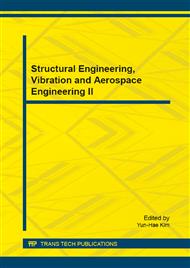[1]
ZHOU Xi-sheng, SONG Hong-wei. Foreign Surrounding Rock Loose Circle Supporting Theory Research Situation[J]. Well Construction Technology , 1994, (4, 5):67-69. ( in Chinese).
Google Scholar
[2]
SHI Xing-guo. Development of Roadway Surrounding Rock Loose Circle Theory[J]. Hebei Coal, 1995, 4(1):1-5. ( in Chinese).
Google Scholar
[3]
XIAO Ming, ZHANG Yu-ting, CHEN Jun-tao, et al. Numerical analysis of excavation damaged zone of underground caverns induced by excavation blasting[J]. Rock and Soil Mechanics , 2010, 31(8): 2613-2618. (in Chinese).
Google Scholar
[4]
REN Qing-wen, ZHANG Hong-chao. A Modification of Fenner Formula[J]. Journal of Hohai University 2001, 29(6):109. ( in Chinese).
Google Scholar
[5]
Hermann Kastner. Tunnels and Trenches Statics[M]. Shanghai: Shanghai Science and Technology Press, 1980. ( in Chinese).
Google Scholar
[6]
DONG Fang-ting. Support Theory and Application Based on the Broken Rock Zone in Surround Rock[M]. Beijing:China Coal Industry Publishing House, 2001. ( in Chinese).
Google Scholar
[7]
LIU Gang, SONG Hong-wei. The Numerical Simulation of The Surrounding Rock Loose Circle of Influence Factors[J]. ChanSha: Mining and Metallurgy Engineering, 2003, 21(1):1-3. ( in Chinese).
Google Scholar
[8]
LI Ling, DUAN Xiao-qiang, CHEN Fang-fang, et al. To ExploresElastoplastic Displacement Back Analysis of Surrounding Rock Loose Circle Method[J]. Wuhan: Journal of Rock Mechanics and Engineering, 2006, 25(7):12-16. ( in Chinese).
Google Scholar
[9]
XIA Feng, BO Jing-shan, ZHENG Tao, et al. Based on Rectangular Cavern Surrounding Rock Loose Circle of FLAC3D[J]. Journal of Institute of Disaster Prevention, 2010, 12(4):66-69. ( in Chinese).
Google Scholar
[10]
XIA Feng. Underground Chamber Rock Loose Circle Influencing Dactors[D]. Harbin: Research at the China Earthquake Administration Institute of Engineering Mechanics, 2006. ( in Chinese).
Google Scholar
[11]
CAI Guan-nan, LI Zhong-hui, YANG Yu-long, et al. Numerical analysis of excavation damaged zone of underground caverns induced by excavation blasting[J]. Industry and Mine Automation , 2010, 31(8): 2613-2618. (in Chinese).
Google Scholar
[12]
YANG Xu-xu., WANG Wen-qing, JING Hong-wen. Analysis and Comparison on Conventional Loose Zone Measuring and Test Methods [J]. Coal Science and Technology, 2012, 40(8):1-5. ( in Chines).
Google Scholar


